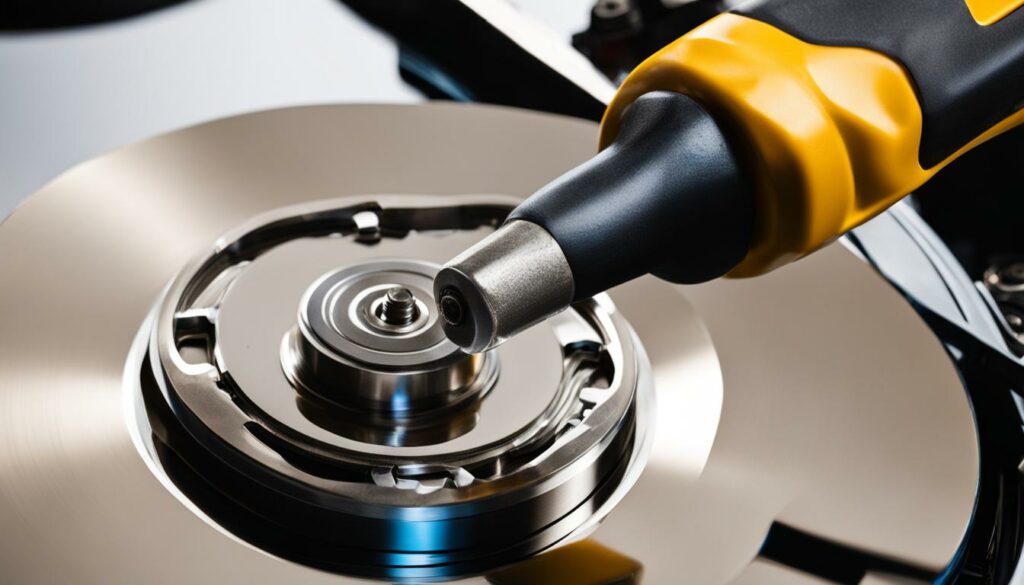Data wipe and format are two different methods used to ensure the security and privacy of data. Data wipe involves permanently deleting and destroying data on a storage device, making it unrecoverable. Format, on the other hand, prepares a storage device for a specific usage by resetting the file system and deleting all saved data. While both methods involve removing data, data wipe is more secure and ensures complete data destruction.
Key Takeaways:
- Data wipe and format are two methods used for data sanitization and secure data deletion.
- Data wipe permanently deletes and destroys data, making it unrecoverable.
- Format prepares a storage device for specific usage by resetting the file system and deleting all saved data.
- Data wipe is more secure and ensures complete data destruction.
- Choose between data wipe and format based on the level of security and privacy required.
What is Data Sanitization?
Data sanitization is a crucial process in ensuring the security and privacy of data stored on memory devices. It involves permanently and irreversibly removing or destroying data to prevent privacy leaks and protect sensitive information. There are several methods used for data sanitization, including physical destruction, degaussing, and data erasure.
Physical Destruction
Physical destruction is a method of data sanitization that involves completely destroying the media. This can be achieved through disintegration, pulverization, melting, incineration, or shredding. Physical destruction is considered the most secure method as it ensures that the data stored on the media is completely unrecoverable. However, it should only be used when the media is no longer needed, as it renders the media unusable.
Degaussing
Degaussing is another method used for data sanitization, particularly for magnetic media. It works by exposing the media to a strong magnetic field, which disrupts the recorded magnetic domain and makes the data unrecoverable. Degaussing is effective for purging diskettes, damaged or inoperative media, and media with large storage capacity. However, it may require specialized degaussing equipment and can be more expensive for modern high-density disks that require higher magnetic fields.
Data Erasure
Data erasure, also known as data wiping, is a widely used method of data sanitization. It involves overwriting the storage space on a media with non-sensitive data, making the original data unrecoverable. This process can be done using specialized software or hardware products. Data erasure is mainly applied to writable media to protect the confidentiality of information against data recovery utilities. However, it’s important to note that while data may not be recoverable through software, there is still a possibility of data recovery in a laboratory environment.
Data Sanitization Methods:
| Method | Description |
|---|---|
| Physical Destruction | Completely destroys the media to ensure data is unrecoverable. |
| Degaussing | Disrupts the recorded magnetic domain of magnetic media, making the data unrecoverable. |
| Data Erasure | Overwrites the storage space on a media with non-sensitive data, making the original data unrecoverable. |
Physical Destruction: Irreversible Data Destruction
Data destruction is a critical aspect of data sanitization, and physical destruction is one of the most secure methods available. It involves completely destroying the media, ensuring that the data stored on it is rendered completely unrecoverable. There are several methods of physical destruction, including disintegration, pulverization, melting, incineration, and shredding.
Disintegration, as the name suggests, involves breaking the media into small particles, making it virtually impossible to retrieve any information from it. Pulverization, on the other hand, pulverizes the media into fine dust, ensuring that no traces of data remain. Melting and incineration involve subjecting the media to extreme heat, effectively melting it down or burning it to ashes. Shredding is another popular method, where the media is shredded into tiny pieces, preventing any chance of data recovery.
Physical destruction is the most secure method of data destruction, as it ensures that the data cannot be recovered even in a laboratory environment. However, it is important to note that physical destruction renders the media unusable, making it suitable only for situations where the media is no longer needed.
Table: Comparison of Physical Destruction Methods
| Method | Description | Advantages | Disadvantages |
|---|---|---|---|
| Disintegration | The media is broken into small particles. | – Ensures complete destruction of data – Difficult to recover any information |
– Renders the media unusable – Requires specialized equipment |
| Pulverization | The media is pulverized into fine dust. | – Leaves no traces of data – Prevents any chance of recovery |
– Requires specialized equipment – Media is rendered unusable |
| Melting | The media is subjected to extreme heat, melting it down. | – Destroys data completely – No chance of recovery |
– Requires high temperatures – Media becomes unusable |
| Incineration | The media is burned to ashes. | – Ensures complete destruction of data – No chance of recovery |
– Requires specialized equipment – Media is rendered unusable |
| Shredding | The media is shredded into tiny pieces. | – Makes data recovery impossible – Provides physical evidence of destruction |
– Requires specialized equipment – Media is rendered unusable |
Degaussing: Disrupting Magnetic Domain
Degaussing is a highly effective method of data sanitization that involves exposing magnetic media to a strong magnetic field, rendering the recorded data irrecoverable. This process disrupts the magnetic domain of the media, making it impossible to retrieve the original data. Degaussing is particularly suitable for diskettes, damaged or inoperative media, and high-capacity storage devices.
To perform degaussing, specialized degaussing equipment is required. This equipment generates a powerful magnetic field that effectively erases the data stored on magnetic media. However, it is important to note that modern high-density disks may require higher magnetic fields, which can be more expensive and necessitate the use of specialized equipment.
By exposing magnetic media to a strong magnetic field, degaussing disrupts the magnetic domain, rendering the data unrecoverable.
Degaussing does not physically damage the media, but it does render it unusable. Therefore, caution must be exercised when considering this method, as it permanently destroys the existing data and makes the media unsuitable for further use.
| Advantages of Degaussing | |
|---|---|
| 1 | Highly effective at rendering data irrecoverable |
| 2 | Suitable for diskettes, damaged or inoperative media, and high-capacity storage devices |
| 3 | Does not physically damage the media |
Overall, degaussing is a secure method of data sanitization that disrupts the magnetic domain of magnetic media, effectively erasing the stored data. While it requires specialized equipment and can render the media unusable, it provides peace of mind by ensuring that the data is unrecoverable.

Data Wiping Methods
In addition to degaussing, there are other data wiping methods that can be used to ensure secure data destruction. These methods involve overwriting the storage space on a media with non-sensitive data, making the original data unrecoverable.
- Software-Based Data Wiping: This method utilizes specialized data wiping software that overwrites the storage space on the media with random patterns of data. Multiple passes are often performed to ensure complete data destruction.
- Hardware-Based Data Wiping: Hardware-based data wiping involves using dedicated hardware devices to overwrite the storage space on the media. These devices provide high-speed and thorough data wiping.
- Secure Erase: Secure erase is a method that is built into some storage devices, allowing for the secure deletion of data. It sends a command to the device to overwrite the storage space with random patterns, ensuring data destruction.
Each data wiping method has its own advantages and considerations, and the choice of method depends on factors such as the type of media, the level of security required, and the resources available.
Data Erasure: Securely Removing Data
Data erasure, also known as data wiping, is a method of data sanitization that involves overwriting the storage space on a media with non-sensitive data. This process ensures that the original data is irrecoverable, even with specialized software. Data erasure is typically performed using specialized software or hardware products designed specifically for this purpose.
Different data wiping methods can be used for data erasure, including overwriting the entire storage space multiple times with random patterns or specific algorithms. This process effectively removes traces of the original data, making it extremely difficult, if not impossible, to recover. It is important to note that data erasure is primarily applied to writable media, such as hard drives, solid-state drives, and flash drives.
One common data erasure method involves overwriting the storage space multiple times with non-sensitive data, such as zeros or random characters. This ensures that the original data is overwritten and no longer accessible. The number of times the storage space is overwritten depends on the desired level of security and privacy. Some data erasure software offers different options for overwriting, allowing users to choose the level of thoroughness that best suits their needs.
The Importance of Overwriting Storage Space
When performing data erasure, it is crucial to overwrite the entire storage space. Overwriting selected files or folders may leave traces of sensitive data behind, making it potentially recoverable. By overwriting the entire storage space, data erasure ensures that all sectors of the media contain non-sensitive data, leaving no room for the original data to be recovered.

Ensuring the Security of Non-Sensitive Data
Data erasure is especially important when disposing of or repurposing storage devices that contain non-sensitive data. Even though the data may not be highly confidential, it is still important to ensure that it cannot be easily accessed or recovered by unauthorized individuals. By securely removing non-sensitive data through data erasure, organizations can protect their information and prevent any potential data breaches.
Summary
Data erasure is a crucial process for securely removing data from storage devices. By overwriting the storage space with non-sensitive data, data erasure ensures that the original data is irrecoverable. It is important to use specialized software or hardware products designed for data erasure to ensure the effectiveness of the process. Whether disposing of old devices or repurposing them, data erasure plays a vital role in maintaining data security and privacy.
Delete vs Format vs Erase vs Wipe: Understanding the Differences
When it comes to data destruction, the terms “delete,” “format,” “erase,” and “wipe” are often used interchangeably. However, they have distinct meanings and implications. Understanding the differences between these actions is crucial for ensuring the security and privacy of your data.
Firstly, “delete” refers to the act of removing a file or data from a storage device. While the data may appear to be gone, it can still be recovered until it is overwritten by new data. “Format,” on the other hand, resets the file system and deletes all saved data on a storage device. However, similar to deletion, the data can still be recovered until it is overwritten by new data using specialized software.
“Erase” and “wipe” are more secure methods of data destruction. “Erase” typically refers to the targeted removal of a specific piece of data, while “wipe” involves the complete destruction of all data on a storage device. Both methods ensure that the original data is overwritten and rendered unrecoverable, providing enhanced security and privacy.
It is important to note that data wipe is the most secure method of data destruction. Unlike deletion or formatting, data wipe ensures complete and irreversible data destruction, making it unrecoverable even in a laboratory environment. If you require the highest level of security and privacy for your data, opting for a data wipe is the recommended approach.

Conclusion
In conclusion, when it comes to data sanitization and secure data deletion, data wipe and format are two different methods with distinct purposes. Data wipe ensures complete and irreversible data destruction, making it unrecoverable, even in a laboratory environment. On the other hand, format prepares a storage device for specific usage by resetting the file system and deleting all saved data.
Both methods involve removing data from a storage device, but the choice between data wipe and format depends on the level of security and privacy required for the data. If you need utmost security and want to ensure that your data is completely unrecoverable, data wipe is the recommended method. However, if you are simply preparing a storage device for reuse and do not need to ensure complete data destruction, format can be a suitable option.
It is important to understand the difference between data wipe and format to choose the appropriate method for your specific needs. Whether you opt for data wipe or format, both methods play a crucial role in data sanitization and secure data deletion, protecting your sensitive information from falling into the wrong hands.
FAQ
What is the difference between data wipe and format?
Data wipe involves permanently deleting and destroying data on a storage device, making it unrecoverable. Format, on the other hand, prepares a storage device for a specific usage by resetting the file system and deleting all saved data.
Why is data sanitization important?
Data sanitization is important to prevent privacy leaks and protect sensitive information. It ensures that data stored on a memory device is permanently and irreversibly removed or destroyed.
What are the major methods of data sanitization?
There are three major methods of data sanitization: physical destruction, degaussing, and data erasure.
How does physical destruction work?
Physical destruction involves completely destroying the media, rendering the data stored on it completely unrecoverable. Methods of physical destruction include disintegration, pulverization, melting, incineration, and shredding.
How does degaussing work?
Degaussing sanitizes magnetic media by exposing it to a strong magnetic field, disrupting the recorded magnetic domain and making the data unrecoverable.
What is data erasure?
Data erasure, also known as data wiping, is a method of data sanitization that involves overwriting the storage space on a media with non-sensitive data to make the original data unrecoverable.
What is the difference between delete, format, erase, and wipe?
Delete removes a file or data from a storage device, but the data can still be recovered until it is overwritten. Format resets the file system and deletes all saved data, but the data can still be recovered until it is overwritten. Erase and wipe involve securely removing data, making it unrecoverable. Erase typically refers to the removal of a specific piece of data, while wipe refers to the complete destruction of all data on a storage device.
